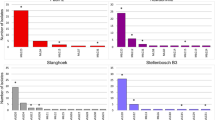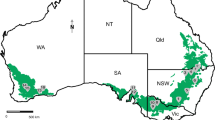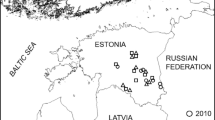Abstract
Fifty eight single-spore Togninia minima (anamorph Phaeoacremonium aleophilum) isolates were recovered from grape rootstock wood of plants that showed symptoms of Petri disease and esca from 2001 to 2008 in Spain. These isolates were studied by means of mating type distribution, UP-PCR analysis, and virulence assays. Analysis of clone-corrected data sets showed equal frequencies of both mating types in the entire Spanish population, in the Ciudad Real region, at inter-vineyard and intra-vine spatial scales; while unequal mating type distribution was detected in Valencia and Zaragoza regions, at intra-vineyard and intra-vine spatial scales. This is the first study on distribution of T. minima mating types on spatial scales varying from vineyards to regions. A total of 49 polymorphic UP-PCR markers were obtained using seven UP-PCR primers. Four optimal clusters were inferred with Bayesian structure and multivariate analyses from the UP-PCR data. The high number of unique genotypes observed within the Spanish population, combined with a near-equal distribution of mating types, suggested that sexual reproduction probably does occur. However, based on allele distribution and frequency, each of the three subpopulations appeared to be evolving independently. Gene and genotype diversities across the subpopulations were similar and ranged from 0.24 to 0.27 and from 0.27 to 0.37, respectively. The detection of genetically identical isolates within and among subpopulations indicates that an asexual reproductive component should not be excluded. Contrast analysis among groups defined by UP-PCR analyses showed no significant differences in the virulence of T. minima isolates.




Similar content being viewed by others
References
Adalat, K., Whiting, C., Rooney, S., & Gubler, W. D. (2000). Pathogenicity of three species of Phaeoacremonium spp. on grapevine in California. Phytopathologia Mediterranea, 39, 92–99.
Ajello, L., Georg, L. K., Steigbigel, R. T., & Wang, C. J. K. (1974). A case of phaeohyphomycosis caused by a new species of Phialophora. Mycologia, 66, 490–498.
Aroca, A., & Raposo, R. (2009). Pathogenicity of Phaeoacremonium species on grapevines. Journal of Phytopathology, 157, 413–419.
Borie, B., Jacquiot, L., Jamaux-Despréaux, I., Larignon, P., & Péros, J. P. (2002). Genetic diversity in populations of the fungi Phaeomoniella chlamydospora and Phaeoacremonium aleophilum on grapevine in France. Plant Pathology, 51, 85–96.
Bulat, S. A., Mironenko, N. V., Lapteva, M. N., & Strelchenko, P. P. (1994). Polymerase chain reaction with universal primers (UP-PCR) and its application to plant genome analysis. In R. P. Adams, J. S. Miller, E. M. Goldenberg, & J. E. Adams (Eds.), Conservation of plant genes II: utilization of ancient and modern DNA (pp. 113–129). St Louis: Missouri Botanical Garden.
Bulat, S. A., Lübeck, M., Mironenko, N., Jensen, D. F., & Lübeck, P. S. (1998). UPPCR analysis and ITS1 ribotyping of strains of Trichoderma and Gliocladium. Mycological Research, 102, 933–943.
Comont, G., Corio-Costet, M.-F., Larignon, P., & Delmotte, F. (2010). AFLP markers reveal two genetic groups in the French population of the grapevine fungal pathogen Phaeomoniella chlamydospora. European Journal of Plant Pathology, 127, 451–454.
Corander, J., Waldmann, P., Marttinen, P., & Sillanpää, M. J. (2004). BAPS 2: enhanced possibilities for the analysis of genetic population structure. Bioinformatics, 20, 2363–2369.
Cottral, E., Ridgway, H. J., Pascoe, I., Edwards, J., & Taylor, P. (2001). UP-PCR analysis of Australian isolates of Phaeomoniella chlamydospora and Phaeoacremonium aleophilum. Phytopathologia Mediterranea, 40, S479.
Cumagun, C. J. R., Hockenhull, J., & Lübeck, M. (2000). Characterization of Trichoderma isolates from Philippine rice fields by UP-PCR and rDNA-ITS1 analysis: identification of UP-PCR markers. Journal of Phytopathology, 14, 109–115.
Damm, U., Mostert, L., Crous, P. W., & Fourie, P. H. (2008). Novel Phaeoacremonium species associated with necrotic wood of Prunus trees. Persoonia, 20, 87–102.
Dhingra, O. D., & Sinclair, J. B. (1995). Basic plant pathology methods (2nd ed., p. 434). Boca Raton: CRC Press.
Eskalen, A., & Gubler, W. D. (2001). Association of spores of Phaeomoniella chlamydospora, Phaeoacremonium inflatipes, and Pm. aleophilum with grapevine cordons in California. Phytopathologia Mediterranea, 40, S429–S432.
Essakhi, S., Mugnai, L., Crous, P. W., Groenewald, J. Z., & Surico, G. (2008). Molecular and phenotypic characterization of novel Phaeoacremonium species associated with Petri disease and esca of grapevine. Persoonia, 21, 119–134.
Evanno, G., Regnaut, S., & Goudet, J. (2005). Detecting the number of clusters of individuals using the software STRUCTURE: a simulation study. Molecular Ecology, 14(8), 2611–2620.
Excoffier, L., Laval, G., & Schneider, S. (2005). Arlequin ver. 3.0: An integrated software package for population genetics data analysis. Evolutionary Bioinformatics Online, 1, 47–50.
Falush, D., Stephens, M., & Pritchard, J. K. (2007). Inference of population structure using multilocus genotype data: dominant markers and null alleles. Molecular Ecology Notes, 7(4), 574–578.
Feliciano, A. J., & Gubler, W. D. (2001). Histological investigations on infection of grape roots and shoots by Phaeoacremonium spp. Phytopathologia Mediterranea, 40, S387–S393.
Fincham, J. R. S., & Day, P. R. (1963). Fungal genetics (3rd ed.). Oxford: Blackwell Scientific Publication.
Glass, N. L., & Donaldson, G. C. (1995). Development of primer sets designed for use with the PCR to amplify conserved genes from filamentous infection due to Phaeoacremonium spp. Journal of Clinical Microbiology, 41, 1332–1336.
Graham, A. B., Johnston, P. R., & Weir, B. S. (2009). Three new Phaeoacremonium species on grapevines in New Zealand. Australasian Plant Pathology, 38, 505–513.
Gramaje, D., & Armengol, J. (2011). Fungal trunk pathogens in the grapevine propagation process: potential inoculum sources, detection, identification and management strategies. Plant Disease, 95, 1040–1055.
Gramaje, D., Armengol, J., Mohammadi, H., Banihashemi, Z., & Mostert, L. (2009). Novel Phaeoacremonium species associated with Petri disease and esca of grapevine in Iran and Spain. Mycologia, 101, 920–929.
Gramaje, D., Armengol, J., Salazar, D., López-Cortés, I., & García-Jiménez, J. (2009). Effect of hot-water treatments above 50 °C on grapevine viability and survival of Petri disease pathogens. Crop Protection, 28, 280–285.
Gramaje, D., García-Jiménez, J., & Armengol, J. (2010). Grapevine rootstock susceptibility to fungi associated with Petri disease and esca under field conditions. American Journal of Enology and Viticulture, 61, 512–520.
Guarro, J., Alves, S. H., Gené, J., Grazziotin, N. A., Muzzuco, R., Dalmagro, C., et al. (2003). Two cases of subcutaneous infection due to Phaeoacremonium spp. Journal of Clinical Microbiology, 41, 1332–1336.
Halleen, F., Mostert, L., & Crous, P. W. (2007). Pathogenicity testing of lesser-known vascular fungi of grapevines. Australasian Plant Pathology, 36, 277–285.
Hausner, G., Eyjólfsdóttir, G. G., Reid, J., & Klassen, G. R. (1992). Two additional species of the genus Togninia. Canadian Journal of Botany, 70, 724–732.
Jombart, T. (2008). Adegenet: a R package for the multivariate analysis of genetic markers. Bioinformatics, 24, 1403–1405.
Jombart, T., Devillard, S., & Balloux, F. (2010). Discriminant analysis of principal components: a new method for the analysis of genetically structured populations. BMC Genetics, 11, 94.
Larignon, P., & Dubos, B. (1997). Fungi associated with esca disease in grapevine. European Journal of Plant Pathology, 103, 147–157.
Lübeck, P. S., Alekhina, I. A., Lübeck, M., & Bulat, S. A. (1998). UP-PCR genotyping and rDNA analysis of Ascochyta pisi Lib. Journal of Phytopathology, 146, 51–55.
Lübeck, M., Alekhina, I. A., Lübeck, P. S., Jensen, D. F., & Bulat, S. A. (1999). Delineation of Trichoderma harzianum into two genotypic groups by a highly robust fingerprinting method, UP-PCR, and UP-PCR product crosshybridization. Mycological Research, 103, 289–298.
Marco, S. D. I., Calzarano, F., Osti, F., & Mazzullo, A. (2004). Pathogenicity of fungi associated with a decay of kiwifruit. Australasian Plant Pathology, 33, 337–342.
Martín, L., & Martín, M. T. (2010). Molecular characterization of Phaeoacremonium aleophilum isolated from grapevines in Castilla y León (Spain). Phytopathologia Mediterranea, 49, 111.
Mead, R., Curnow, R. N., & Hasted, A. M. (2003). Statistical methods in agriculture and experimental biology (3rd ed.). Washington: CRS.
Mostert, L., Crous, P. W., Groenewald, J. Z., Gams, W., & Summerbell, R. C. (2003). Togninia (Calosphaeriales) is confirmed as teleomorph of Phaeoacremonium by means of morphology, sexual compatibility and DNA phylogeny. Mycologia, 95, 646–649.
Mostert, L., Groenewald, J. Z., Summerbell, R. C., Sutton, D. A., Padhye, A. A., & Crous, P. W. (2005). Species of Phaeoacremonium associated with human infections and environmental reservoirs in infected woody plants. Journal of Clinical Microbiology, 43, 1752–1767.
Mostert, L., Groenewald, J. Z., Summerbell, R. C., Gams, W., & Crous, P. W. (2006). Taxonomy and pathology of Togninia (Diaporthales) and its Phaeoacremonium anamorphs. Studies in Mycology, 54, 1–115.
Mugnai, L., Graniti, A., & Surico, G. (1999). Esca (black measles) and brown wood-streaking: two old and elusive diseases of grapevines. Plant Disease, 83, 404–416.
Nei, M. (1973). Analysis of gene diversity in subdivided populations. Proceedings of the National Academy of Sciences of the United States of America, 70, 3321–3323.
O’Donnell, K., & Cigelnik, E. (1997). Two divergent intragenomic rDNA ITS2 types within a monophyletic lineage of the fungus Fusarium are nonorthologous. Molecular and Phylogenetic Evolution, 7, 103–116.
Pascoe, I. G., Edwards, J., Cunnington, J. H., & Cottral, E. (2004). Detection of the Togninia teleomorph of Phaeoacremonium aleophilum in Australia. Phytopathologia Mediterranea, 43, 51–58.
Péros, J. P., & Berger, G. (1994). A rapid method to assess the aggressiveness of Euypa lata isolates and the susceptibility of grapevine cultivars to Eutypa dieback. Agronomie, 14, 515–523.
Péros, J. P., Jamaux-Despréaux, I., & Berger, G. (2000). Population genetics of fungi associated with esca disease in French vineyards. Phytopathologia Mediterranea, 39, 150–155.
Pritchard, J. K., Stephens, M., & Donnelly, P. (2000). Inference of population structure using multilocus genotype data. Genetics, 155, 945–959.
Réblová, M., & Mostert, L. (2007). Romellia is congeneric with Togninia, and description of Conidiotheca gen. nov. for one species of this genus with polysporous asci. Mycological Research, 111, 299–307.
Réblová, M., Mostert, L., Gams, W., & Crous, P. W. (2004). New genera in Calosphaeriales: Togniniella and its anamorph Phaeocrella, and Calosphaeriophora as Anamorph of Calosphaeria. Studies in Mycology, 50, 533–550.
Rice, W. R. (1989). Analyzing table of statistical tests. Evolution, 43, 223–225.
Rooney-Latham, S., Eskalen, A., & Gubler, W. D. (2005a). Teleomorph formation of Phaeoacremonium aleophilum, cause of esca and grapevine decline in California. Plant Disease, 89, 177–184.
Rooney-Latham, S., Eskalen, A., & Gubler, W. D. (2005b). Occurrence of Togninia minima perithecia in esca-affected vineyards in California. Plant Disease, 89, 867–871.
Rumbos, I. C. (1986). Phialophora parasitica, causal agent of cherry dieback. Journal of Phytopathology, 117, 283–287.
Scheck, H. J., Vasquez, S. J., & Gubler, W. D. (1998). First report of three Phaeoacremonium spp. causing young grapevine decline in California. Plant Disease, 82, 590.
Stoddart, J. A., & Taylor, J. F. (1988). Genotype diversity: estimation and prediction in samples. Genetics, 118, 705–711.
Tegli, S., Santilli, E., Bertelli, E., & Surico, G. (2000). Genetic variation within Phaeoacremonium aleophilum and P. chlamydosporum in Italy. Phytopathologia Mediterranea, 39, 125–133.
Tibayrenc, M., Kjellberg, F., Arnaud, J., Oury, B., Brenière, S. F., Dardé, M. L., et al. (1991). Are eukaryotic microorganisms clonal or sexual? A population genetics vantage. Proceedings of the National Academy of Sciences, 88, 5129–5133.
Williams, J. G. K., Kubelik, A. R., Livak, K. J., Rafalski, J. A., & Tingey, S. V. (1990). DNA polymorphism amplified by arbitrary primers are useful as genetic markers. Nucleic Acids Research, 18, 6531–6535.
Yeh, F. C., Yang, R. C., & Boyle, T. (1999). POPGENE version 1.32, The Microsoft Window based freeware for Population Genetic Analysis, Edmanton, Alberta: University of Alberta, available in the internet at http://www.ualberta.ca/~fyeh/fyeh.
Zanzotto, A., Gardiman, M., & Lovat, L. (2008). Effect of Phaeomoniella chlamydospora and Phaeoacremonium sp. on in vitro grapevine plants. Scientia Horticulturae, 116, 404–408.
Zhan, J., Kema, G. H. J., Waalwijk, C., & McDonald, B. A. (2002). Distribution of mating type alleles in the wheat pathogen Mycosphaerella graminicola over spatial scales from lesions to continents. Fungal Genetics and Biology, 36, 128–136.
Acknowledgments
We thank M. G. Milgroom (Department of Plant Pathology and Plant-Microbe Biology, Cornell University) and M. Berbegal (Instituto Agroforestal Mediterráneo, UPV) for providing valuable advice on the writing of this manuscript. The authors gratefully acknowledge M. León (Instituto Agroforestal Mediterráneo, UPV) for technical assistance, and B. B. Landa, R. Pineda and J. A. Navas (Institute of Sustainable Agriculture, CSIC) for assistance with cluster analyses. Financial support by the ‘Programa de Apoyo a la Investigación y Desarrollo (PAID-00-09) de la Universidad Politécnica de Valencia for D. Gramaje during his three months stay in New Zealand is gratefully acknowledged. This research was financially supported by the projects RTA2007-00023-C04-03 and RTA2010-00009-C03-03 (Instituto Nacional de Investigación y Tecnología Agraria y Alimentaria, INIA, Spain) and the European Regional Development Fund (ERDF).
Author information
Authors and Affiliations
Corresponding author
Rights and permissions
About this article
Cite this article
Gramaje, D., Armengol, J. & Ridgway, H.J. Genetic and virulence diversity, and mating type distribution of Togninia minima causing grapevine trunk diseases in Spain. Eur J Plant Pathol 135, 727–743 (2013). https://doi.org/10.1007/s10658-012-0110-6
Accepted:
Published:
Issue Date:
DOI: https://doi.org/10.1007/s10658-012-0110-6




